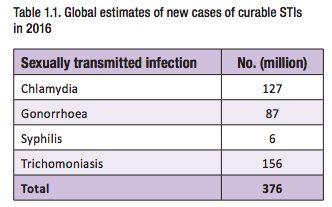
10 minute read
Women s reproductive health (A Hernandez Calderon, H Lohmar, C Hamilton, E Park
Women’s Reproductive Health Haylie Lohmar, PharmD Student, Ana Hernandez, PharmD Student, Esther Park, BSPS Student, Catera Hamilton, PharmD & BSPS Student Globally women and girls, especially those living in poverty, lack access to adequate information, guidance, and services regarding their reproductive health. Spring 2020

Advertisement
Introduction Stigma and taboos around women’s health remain pervasive in most societies. These effects have have serious negative consequences on women. For example, taboo around menstruation can prevent access to hygiene products, prevent partaking in school and sport activities and increases the risk of infection. Stigma around reproductive health can and is leading to a lack of maternal healthcare services and patients in the LGBTQ community have an increasingly difficult time finding supportive healthcare. Period shame has negative mental effects as well; it disempowers women by causing them to feel ashamed about a normal biological process. While we have not discussed every topic surrounding women’s reproductive health, we have chosen a few broad topics to provide a general understanding. We understand these topics and those left out can be difficult to understand and discuss for some people, but in an effort to break down barriers and provide education from a healthcare perspective we have chosen to focus on the following topics. It is crucial to have discussions about menstruation and how it is a developmental milestone and a important health sign. As healthcare providers we must equip adolescent girls and their key support group/influencers with the knowledge they need to manage their periods comfortably and with confidence. We must advocate for unrepresented issues like these that affect the daily lives of women. For example, more than 800 women die daily from preventable causes related to pregnancy and childbirth. We can make a difference!
Education “Misinformation is potentailly more dangerous than malpractice” -Esther Park

Issue: Women’s reproductive health is not a “one size fits all” issue. Each woman has different reproductive needs, cycles, and symptoms; advice for one is rarely relevant to the whole population. Understanding how to sift through what advice is best suited to each individual begins with understanding educating the masses. In developing countries, a study found that 60% of women were dissatisfied with the amount of prenatal care information that was given during consultations at primary health care centers. Studies also show a positive correlation between delivery mortality and lack of knowledge of delivery risks and danger signs. misinformation can cause irreversible harm or consequences to undereducated girls. Menopause- Women approaching menopause have a specific set of symptoms and potential ailments different than those previously experienced. Treatment and precautions, as well as general knowledge about their conditions are typically relayed by their primary health care providers. Those unable to afford or attend annual check ups and maintain contact with such healthcare providers miss this crucial information. Pregnancy- Pregnant women require proper education and information for both their and their baby’s health. Studies have shown the benefits of prenatal education and the dire need for such to reach broader audiences. A study shows that in Bangladesh, preconceived notions and traditional practices for pregnant women thought to be healthful for the babies were actually detrimental to the health of their unborn children. Contraceptives- Women between these age groups must still be looking out for their own reproductive health. A study conducted regarding women’s preferred contraceptives in comparison to their currently used contraceptives showed a large misalignment. These disparities spanned categories including cost and coverage, need, and method. By understanding options and one’s own health, women can make educated decisions to suit what is best for them. Efforts/Solutions: Research shows that women are interested and invested in their own reproductive health; in fact, they recognize how impactful it may be to their general well being. Women were found to have preference for their reproductive health care providers for non-reproductive care, including primary care and mental health. Quality and trustworthy independent research can be conducted through credible sources, such as the CDC’s page on women’s health. Who is affected: Menstruation- Girls at a young age should receive information about their menstruation, sex education, menopause, etc. Taboos and stigmas surrounding women’s reproductive health may hinder girls from an all encompassing discussion. Unaddressed myths and https://en.wikipedia.org/wiki/Reproductive_health#/media/File:Maternal_mortality_rate_worldwide.jpg Maternal Mortality Rates
Access “Women all around the world undergo a very important and difficult physiological process that prepares their body for the miracle of conception. Women should be able to embrace menstruation and be comfortable when seeking care and understanding. It is time to break stigmas and target the present lack of access in order to effectively receive proper care.” - Ana Hernandez
Issue: On any given day, more than 800 million women and girls are menstruating -- yet menstrual hygiene and health is a neglected development and health issue. Taboos, stigma, and ignorance about periods harm girls everyday. There is a lack of access to menstrual products (tampons, menstrual pads), hygiene products, medications, and information. It is a global sanitation issue affecting many people around the world. The cultural shame that comes along with menstruation and resource shortage stop women from living normal lives like going to school and working. According to UNICEF, poor menstrual hygiene cause many physical health risks linked to reproductive and urinary tract infections. Who is affected: It is a global sanitation issue that affects many people - globally around 2 billion people live without sanitation services - according to UNICEF ONLY 27% of people in developing countries have adequate hand washing facilities at home. Young boys are also affected by this issue; educating boys and girls at an early age at school and at home promotes healthy habits and breaks that societal stigma. There is also a cultural shame that comes with menstruation in many places stop them from talking about period management to prevent complications like infections. For example, in Nepal menstruating women as seen as dirty/impure by their communities and are banished to huts during their cycles. Also, a study conducted in Uganda found that many young girls skipped school while menstruating to avoid teasing by classmates. Efforts/solutions: Current solutions focus on providing access to affordable and safe products; a handful of US states have passed laws that mandate schools to provide period products to students. The Department of Education and the MINA foundation called on the government to treat period product as health necessities - to help them stay in school. These efforts have helped fund products in bathrooms to protect students. On the global level, the WSSCC is working towards improvements in sanitation/hygiene in vulnerable communities. This certain organization aims to stop the menstruation stigma and change the policy through education/behavior change with some interesting intensives like having menstrual waste workshops, and promoting toilet designs that wandle waste (India).

Sexually Transmitted Infections “STIs can affect anyone, as healthcare providers it is our responsibility to remove stigma and offer treatment and prevention for all patients. These infections are curable and we need to cure the patients.” - Haylie L Issue: There are more than 30 infections that can be transmitted sexually, the majority of estimates are based on four curable STIs: chlamydia, gonorrhea, trichomoniasis and syphilis. The WHO estimates the global and regional prevalence from literature reviews every 5 years. In 2016 it was estimated 376 million new infections were reported of the four curables STIs. However, these estimates may not be accurate because fewer prevalence studies are being funded in representative populations to provide robust data. Additionally, data from 2016 estimated 417 million cases of herpes simplex virus and 291 million women infected with HPV. Who is affected: Anyone can be infected with an STI, young people and gay and bisexual men are at greatest risk. Young women will face the most serious long-term health consequences from an STI. In 2018, the US reported 2.4 million STI (1.8 million in 2013), half of the STIs are among the youth.
Efforts/solutions: WHO Goals for 2030
●<50 cases of congenital syphilis per 100,000 live births in 80% of countries ●90% reduction in T. pallidum incidence globally ●90% reduction in N. gonorrhoeae incidence globally ●90% national vaccination coverage and at least 80% district coverage in countries with HPV vaccine in their national immunization programme.
In the US
The US Department of Health and Human Services is working with respective parties to to develop a STI Federal Action Plan for STI prevention, diagnosis, treatment and care to improve outcomes. The STI Federal Action Plan is set to be released in 2020. Moving forward: Public health communities need to ensure effective prevention, screening, diagnosis and treatment interventions are more widely available. Public education on these efforts as well as removing any stigma should be reinforced.
Pregnancy “The emphasis must be not on the right to abortion but on the right to privacy and reproductive control.” - Ruth Bader Ginsburg
Background Pregnancy and the birth of a child are big milestones for women across the world, however, this can be a very stressful time for a lot of women for a variety of reasons, especially women wish to opt out of the pregnancy. There are many reasons as to why a woman may not chose to continue, including saving their own life, preserving their own health, broad social or economic grounds and personal choice. We believe there is still a stigma surrounding women who become pregnant and choose to have an abortion, regardless of reason for this procedure or marital status. Issue: 970 million women, representing 59% of women of reproductive age, live in countries that broadly allow abortion and 41% live under restrictive laws. These legal restrictions on abortion do not result in fewer abortions. This leads to women risking their lives and health by seeking out unsafe abortion care. Who is affected:This issue affects 700 million women of reproductive age. According to the World Health Organization, 23,000 women die of unsafe abortion each year and many more experience significant health complications due to improper medical care during this time. Efforts/solutions: In the U.S., Planned Parenthood is a great resource for information and access to proper care, for prevention, pregnancy and abortions, as well as other topics relating to reproductive health. Over the past several decades globally, nearly 50 countries liberalized their abortion laws so that more women have access. Moving forward: Currently, there’s a lot of controversy around this topic, not just in the U.S., but globally and we can expect more developments in the future. There should be more education for women about what their options are (varying depending on the country), the risks of unsafe abortions and overall reproductive health.
References
1.Global Fund for Women: Champions for Equality.. Sexual and Reproductive Health and Rights. Available at:https://www.globalfundforwomen.org/sexual-reproductive-health-rights/. Accessed on 2/13/2020 2.He K, Dalton VK, Zochowski MK, Hall KS. Women's Contraceptive Preference-Use Mismatch. J Womens Health (Larchmt). 2017;26(6):692–701. doi:10.1089/jwh.2016.5807 3.Hall KS, Harris LH, Dalton VK. Women's Preferred Sources for Primary and Mental Health Care: Implications for Reproductive Health
Providers. Women's Health Issues. 2017;27(2):196–205. doi:10.1016/j.whi.2016.09.014 4.Al-Ateeq MA, Al-Rusaiess AA. Health education during antenatal care: the need for more. Int J Womens Health. 2015;7:239–242.
Published 2015 Feb 18. doi:10.2147/IJWH.S75164 5.Sanchez E, Rodriguez L. Global Citizen. Period Poverty: Everything You Need to Know. Available at: https://www.globalcitizen.org/en/content/period-poverty-everything-you-need-to-know/ Accessed February 17, 2020. 6.Scaccia A. Free The Tampons. The Price Young Girls Pay When Tampons Aren’t Free. Available at: https://www.freethetampons.org/the-price-young-girls-pay-when-tampons-arent-free.html Assesed February 17, 2020. 7.Monteleone P, Mascagni G, Giannini A, et al. Symptoms of Menopause - global prevalence, physiology and implications. Nat Rev
Endocrinol. 2018;14(4): 199-215. DOI:10.1038/nrendo.2017.180. 8.Direkvand-Moghadam A, Sayehmiri K, Delpisheh A, et al. Epidemiology of premenstrual syndrome (PMS) - a systematic review and meta-analysis study. JCDR. 2014; 8(2): 106-9. DOI: 10.7860/JCDR/2014/8024.4021. 9.U.S. Department of Health and Human Services. Premenstrual syndrome (PMS). Available at: https://www.womenshealth.gov/menstrual-cycle/premenstrual-syndrome. Accessed on Feb 4, 2020. 10.U.S. Department of Health and Human Services. Endometriosis. Available at: https://www.womenshealth.gov/a-z-topics/endometriosis.
Accessed on Feb 4, 2020. a.Background information and other data surrounding endometriosis is the United States is provided. 11.Centers for disease control and prevention. PCOS (polycystic ovary syndrome) and diabetes. Available at: https://www.cdc.gov/diabetes/basics/pcos.html. Accessed on Feb 4, 2020. 12.Newman L, Rowley J, Vander Hoorn S, et al. Global estimates of the prevalence and incidence of four curable sexually transmitted infections in 2012 based on systemic review and global reporting. 2015; PLoS ONE 10(2). DOI: 10.1371/journal.pone.0143304 13.Narasimhan M, Pedersen H, Ogilvie G, et al. The case for integrated human papillomavirus vaccine and HIV prevention with broader sexual and reproductive health and rights services for adolescent girls and young women. 2017 Trans R Soc Trop Med Hyg 111(4) 141-3.
DOI:10.1093/trstmh/trx032. 14.Center for Reproductive Rights. (n.d.). The World's Abortion Laws. Retrieved March 31, 2020, from https://reproductiverights.org/worldabortionlaws?category[294]=294 15.Parenthood, P. (n.d.). Official Site. Retrieved from https://www.plannedparenthood.org/











